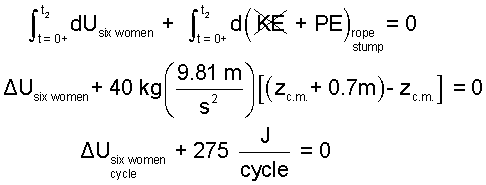| THERMO Spoken Here! ~ J. Pohl © | TOC NEXT ~ 189 |
Mao Zedong

ordered massive tracts of land along the banks of the Yellow River to be cleared of trees and turned to agriculture. But snow and rain flowed from the mountains across the treeless banks and stripped fertile soil into Yellow River, whereupon it was carried all the way to the Yantze to contribute to severe flooding. Next, to control the flooding, Mao had his people build large dikes along the Yantze - by hand.
The sketch depicts a circle of six women operating a dead-weight compactor which was no more than a short, dense tree stump banded by a steel strap to which six ropes were attached. Leaning back in unison, each woman would pull her rope and all pulling together, the stump would be hoisted from the ground, chest high then let to fall, slamming into the ground to pack the loose earth tighter.

Each repetition of impact required about 3 seconds. Except for short breaks for water, the Chinese women operated such devices about eight hours per day.
Estimate the average horsepower of this "compaction machine."
♦ We defined the system to be the six women, the ropes and the stump; taken together. The steady "horsepower equivalent" of the compactor will equal the average rate of energy expenditure of the women which will occur during the lifting portion of each cycle. There is no work for this effort because the women, ropes and stump are interior to the system. The women will perspire but we assume the heat to be small. The rate-form energy equation reduces as follows:

| (1)1 |
When the stump is lifted it attains energy. That energy is supplied by the workers . Upon release, the stump falls and upon impact the ground and thereby delivers the energy to the ground. We will inspect the lifting portion of one cycle of the compactor.
Multiplying equation (1) by "dt" our rate-form energy equation becomes a differential form. In this new equation the energy terms divides into part for the stump and a part for the women, collectively.

| (2)2 |
The kinetic and potential energy changes of the women are negligibly small and the internal energy of the ropes and stump will change, inconsequentially, with each event.

| (3)3 |
Let two times within each cycle be defined. At the time, t = 0+, the stump is on the ground with zero velocity, but at that instant the ropes are taught and the stump is about to be lifted by the women. The second time, t = 3 seconds is when the stump attains the top height of its lift. In this highest position instantaneous velocity is zero. It is between these times that the effort of the women occurs. Note the women provide effort, not work. With the cycle defined this way, the kinetic energy of the stump will be zero initially and finally; over this part of the event cycle. Thus using our approximated height, for one cycle of compaction:

| (4)4 |
The power that makes the compacter operate is the physiological effort of the women. The energy rate can be approximated as:

| (5)5 |
"Work to Food Ratio" With regard to rations, suppose 1,000 kilo-calories of food per day was supplied. Each physical body required about 700 kilo-calories to sustain health and life leaving 300 kilocalories for strenuous work. The women worked eight-hour days.

| (6)A calorie “thermal measure” equals one kilocalorie “nutritional measure.” |
Thus insufficient nutritional energy is provided for this strenuous "work effort" to sustain itself.
Mao Zedong

... ordered massive tracts of land along the banks of the Yellow River to be cleared of trees and turned to agriculture. But snow and rain flowed from the mountains across the treeless banks and stripped fertile soil into Yellow River, whereupon it was carried all the way to the Yantze to contribute to severe flooding. Next, to control the flooding, Mao had his people build large dikes along the Yantze - by hand.
Premise presently unwritted!